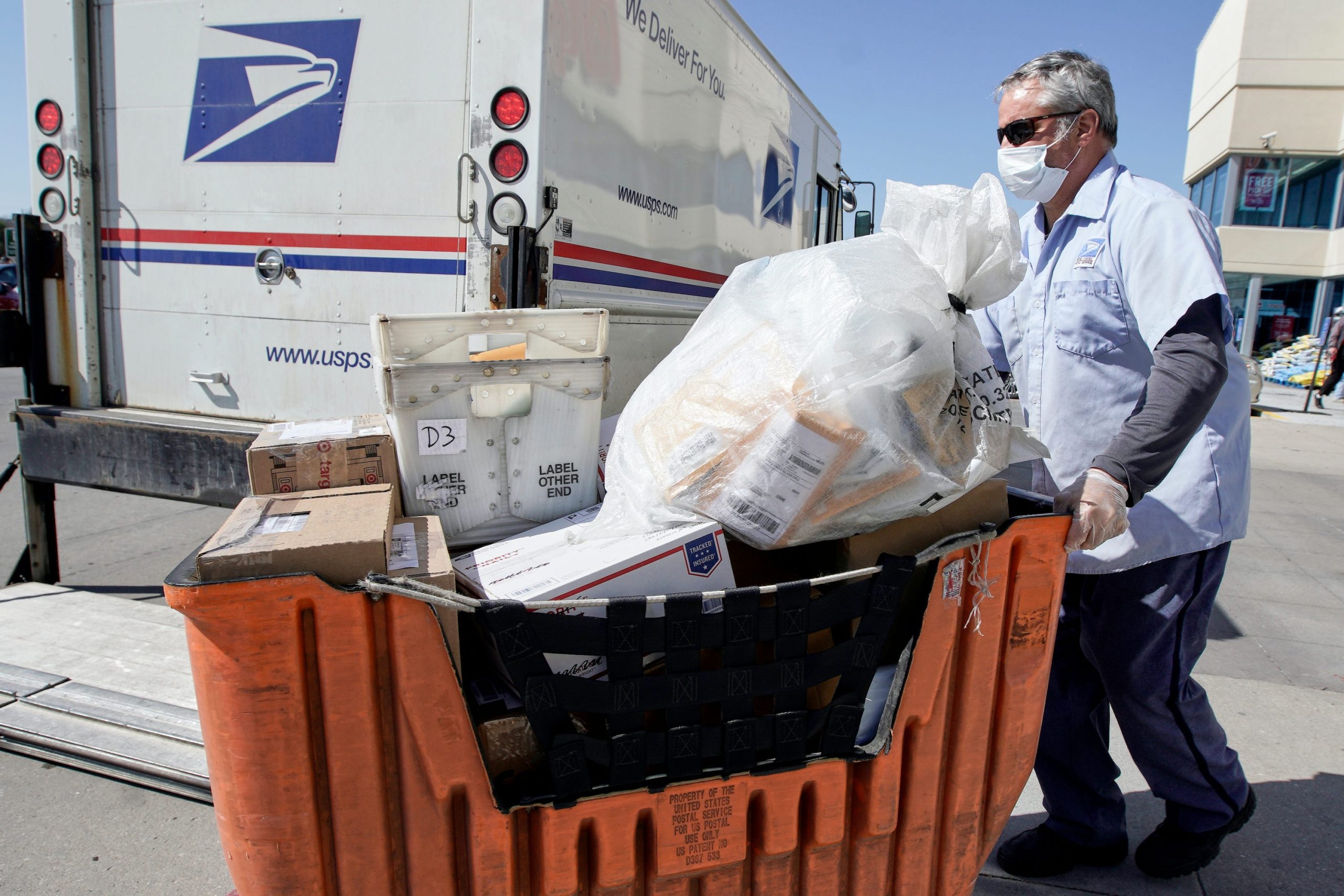- Hundreds of US Postal Service workers have tested positive for the novel coronavirus, but the chances of contracting COVID-19 from a contaminated piece of mail are extremely small, experts say.
- The novel coronavirus only lives for a few hours on paper – possibly less in harsh shipping conditions – and the transfer rate of viruses from paper to a person’s fingers is extremely low, only 1-2%, according to Dr. Charles Gerba, a professor of microbiology at the University of Arizona.
- Plastic packaging and plastic packing tape have a higher transfer rate than paper, and allows the virus to live longer on its surface, theoretically increasing a person’s chances of picking up the virus on their fingers, according to Gerba.
- The Centers for Disease Control and Prevention and the World Health Organization both say that the novel coronavirus spreads mainly through person-to-person contact.
- Visit Business Insider’s homepage for more stories.
Hundreds of cases of COVID-19 have been reported within the US Postal Service, and thousands of employees have had to self-quarantine, so some people may be concerned about contracting the coronavirus from a contaminated piece of mail.
But there are several reasons why you may not need to worry about getting sick from your postal mail.
As it turns out, getting the mail is quite safe even in the midst of a global pandemic, according to experts Business Insider spoke with. Dr. Charles Gerba, a professor of public health and microbiology at the University of Arizona, and Dr. Bernard Camins, an infectious disease specialist and a professor of medicine at the Mount Sinai Health System in New York City, both told Business Insider that the risk of falling ill as a result of a contaminated piece of mail is incredibly low.
“The chances of COVID-19 being spread through the mail that you receive is extremely low, and not something that people need to worry about at all,” Camins said. Both he and Gerba said that the novel coronavirus likely can’t survive for very long on mail under normal shipping conditions, and that only trace amounts of the virus are able to transfer from paper to a person’s fingers. According to both experts, though contaminated objects could potentially pose some risk, people’s main concern should be maintaining social distance in public.
Both experts said that a large number of cases among postal workers - though a serious problem in its own right - likely doesn't pose a public-health risk as far as getting the virus from a piece of mail. Recent studies, along with recommendations from the Centers for Disease Control and Prevention and the World Health Organization, back up their claims.
Here's why you shouldn't be too concerned about contracting COVID-19 through the mail, despite the growing number of confirmed cases within the US Postal Service:
The novel coronavirus dies fairly quickly on paper, according to a recent study.
A recent study published in the journal The Lancet found that the novel coronavirus only lives for three hours on printing paper and tissue paper. According to Camins, lab studies may not reflect real-world conditions, so it's possible that the virus' lifespan would be even shorter in practical situations, where conditions are not monitored or controlled.
By comparison, the same study found that the novel coronavirus could survive for up to a week on plastic or stainless steel. That means that even if a piece of mail was to become contaminated with the COVID-19-causing virus, the virus would likely die before it reached your mailbox.
Viruses transfer from paper to a person's fingers at an extremely low rate, according to experts Business Insider spoke with.
Even if an envelope does become contaminated and the virus is still alive when it reaches a person's home, the chances of transmission to a person's fingers are slim to none.
"We had people touch all kinds of surfaces with viruses on them, and paper was probably the least worrying of the whole group," Gerba said, referring to his past research. "There was only about 1-2% transfer of any viruses from touching the surface, whereas a stainless steel door knob or push plate, or a smooth plastic surface, is about 70%."
That's largely due to the porous nature of paper, Gerba says. Microorganisms like the novel coronavirus get trapped in paper's tiny holes and crevices, making transfer to the fingers unlikely. Smooth surfaces like metal or plastic, however, facilitate the transfer of viruses at a much higher rate.
A good rule of thumb, according to Gerba: "Generally, the easier it is to clean a surface, the easier it is to transfer something to your fingers."
Camins says that at Mount Sinai Hospital, where he works, healthcare workers sometimes express concerns about the virus lingering on patient consent forms, but the hospital has not issued a policy on the matter since paper is such a poor conduit for the virus. "Paper is fine. We just say to wipe their pens - pens are plastic - if they're really worried," Camins said.
Paper can actually kill the virus, Gerba says.
Not only is paper an inhospitable environment for viruses in terms of their lifespan and rate of transfer, the material can actually kill the organism itself, according to Gerba. Paper is absorbent, so it draws moisture out of the virus "like a paper towel," desiccating it, Gerba said.
"That's why metal and plastic have a higher rate of transfer," Camins said, referring to the fact that paper dries out the virus, while other surfaces may stay moist for longer.
The overall threat the mail poses is slim, but the type of mail you receive could potentially increase your chances of getting sick, according to Gerba.
Paper mail is highly unlikely to transfer the virus to a person's fingers in any significant quantity, but plastic packaging and packing tape may pose a slightly greater risk of infection, Gerba said.
"My only concern is if it's plastic-wrapped or if there's plastic tape. Maybe I'm over-paranoid, but because I know the transfer is greater from plastic, I usually wipe it down with a disinfectant wipe," Gerba said. However, Gerba said, plastic packaging is only "a little bit more of a concern" than normal paper mail, which he does not worry about at all.
Additionally, a study published March 17 in the New England Journal of Medicine indicated that the novel coronavirus could live on cardboard for up to a day.
So, at least theoretically speaking, there may be an increased likelihood for a package or a plastic mailer, for instance, to harbor the virus and transmit it to a mail recipient, as compared with regular paper mail.
At least 74 Amazon facilities have reported cases of the COVID-19, and on Tuesday Amazon had its first warehouse-worker death from the virus.
In a statement to Business Insider, Amazon spokesperson Av Zammit said: "We are saddened by the passing of a member of our management team in Hawthorne, California. His family and loved ones are in our thoughts, and we are supporting his fellow colleagues."
The novel coronavirus probably can't survive for very long under normal shipping conditions, according to the WHO and the CDC.
Both Gerba and Camins said that - based on new research as well as what is known about other coronaviruses - the novel coronavirus is relatively unstable and is sensitive to changes in temperature and humidity. They both said that shipping conditions are likely inhospitable for the novel coronavirus.
On its website, the CDC says, "Although the virus can survive for a short period on some surfaces, it is unlikely to be spread from products or packaging that are shipped over a period of days or weeks at ambient temperatures."
Similarly, the WHO says, "The likelihood of an infected person contaminating commercial goods is low and the risk of catching the virus that causes COVID-19 from a package that has been moved, travelled, and exposed to different conditions and temperature is also low. "
There has never been an illness that was transmitted through the mail in any significant way, according to Gerba.
Gerba, whose years of research on germs have earned him the nickname Dr. Germ, is not aware of any illness that was proven to have spread through the mail, aside from anthrax, which was deliberately disseminated that way.
"People shouldn't confuse [the novel coronavirus] with anthrax spores, which are incredibly stable and easily aerosolized," Gerba said. "That's a much different organism."
The WHO and CDC both say that the novel coronavirus likely spreads primarily through person-to-person contact, rather than through contact with contaminated objects.
Guidance from both the World Health Organization and the CDC states that though the virus can spread through contact with contaminated surfaces, it mainly spreads through person-to-person contact. According to the CDC, "The virus that causes COVID-19 is thought to spread mainly from person to person, mainly through respiratory droplets produced when an infected person coughs or sneezes."
For that reason, all the experts Business Insider spoke with said that people's main concern as they go through life during this pandemic should be to follow social-distancing guidelines, and to wash their hands, and avoid touching their faces. Camins says he's typically a friendly guy who chats up MTA conductors, cab drivers, and mail carriers, but, "Until this thing is over, I'm not going to talk, so they don't talk to me."
If mail carriers keep their distance, wear protective equipment, and stay home if they are sick, the chances of them contracting or spreading COVID-19 through person-to-person contact is low, both the experts Business Insider spoke with said.
Even taking into account the high number of COVID-19 cases within the US Postal Service, both Camins and Gerba said that as long as mail carriers practice social distancing, wear face coverings, and self-quarantine if necessary, the risk of infection to themselves and to the mail-receiving public is minimal.
However, for many postal employees, that may be easier said than done. According to prior reporting by Business Insider, some postal workers feel that the US Postal Service is not doing enough to protect them from coming down with COVID-19. Mail carriers have resorted to mixing their own hand sanitizer and purchasing gloves out of pocket.
According to reporting from ProPublica on Tuesday, US Postal Service workers are not being informed by their employer when their colleagues test positive for COVID-19, meaning they don't know when to self-quarantine and may be unwittingly working while carrying the virus.
So, though the risk of contracting coronavirus through the mail may be insignificant, the pandemic's impact on the US Postal Service and its workers may prove severe.

